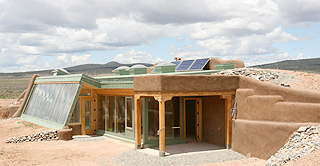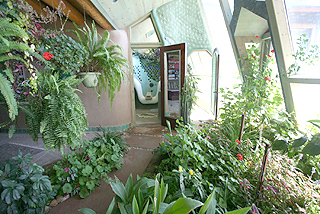
Surveys
DJC.COM
June 26, 2008
Will Earthships save the Earth?
Special to the Journal

Lambert
|
Homes called Earthships have been sprouting up across the globe for the past 30 years, and Earthship Biotecture’s mission “to find and distribute knowledge about sustainable lifestyles” continues to evolve as communities across the world witness, and embrace, these environmentally green ideas.
Earthship Biotecture, based in Taos, N.M., and founded by eco-architect Michael Reynolds, has grown into a global company and learning center. It is not only building Earthships in the U.S. and Europe, but is reaching out to poverty- and disaster-stricken areas, such as India and Africa, that are now overflowing with garbage and are in desperate need of shelter and sustainable resources.
Motivated by the energy crisis in the mid-1970s, Reynolds decided to make a change and use his skills as an architect to come up with the Earthship concept. His ambition was to build an affordable home that would produce energy from wind and the sun, collect water from rain and snow, contain and treat sewage, and manufacture biodiesel fuel. But the most unique idea of his was that he would do this all by using garbage as the prime structural material.

Image courtesy of Earthship Biotecture This private home was built in the Greater World Earthship Community in Taos, N.M. |
“Garbage did not exist until there were humans,” Reynolds said. “Everything in nature easily goes back into the earth. Humanity needs to learn to re-consume.”
It’s been more than 30 years and Reynolds is still building Earthships. His work that once sparked a kind of green revolution is now catching on like wildfire.
Earthships
Earthships are really about melding physics, biology and architecture to effectively and comfortably live harmoniously with the Earth. They can be defined as a passive solar home made of natural and recycled materials. These materials, such as aluminum cans and bottles, are molded into walls, and dirt-filled tires are pounded and stacked like bricks. This builds the thermal mass construction for temperature stabilization.
Renewable energy and integrated water systems, such as solar energy and rain, are used, making the Earthship an off-grid home, with little to no utility bills.
Reynolds coined the term “biotecture” through his use of biology and architecture over the decades. Biotecture is now known as the profession of designing buildings and environments with consideration for their sustainability.
To successfully implement and teach these basics of sustainable living, Reynolds developed six design principles covering:
1. Thermal/solar heating and cooling, which involves thermal mass, insulation and ventilation.
2. Solar and wind electricity.
3. Contained sewage treatment.
4. Building with natural and recycled materials.
5. Water harvesting.
6. Food production.
These principles are used not only in the construction of Earthships, but in retrofitting as well.
Retrofitting
Retrofitting existing structures is a sister to building new Earthships that is just as, if not more, environmentally important.

Images courtesy of Earthship Biotecture
A botanical cell can be found inside the Phoenix Earthship in Taos. The home can be rented on a nightly basis.
|
According to the Environmental Protection Agency, the average American house generates more than twice the amount of greenhouse gases that the typical car produces. Most of this pollution comes from temperature control, electricity and waste.
“By retrofitting you can essentially eliminate the pollution and the utility bills your house produces,” said Reynold’s son, Jonah. “We can build a million Earthships a year, but it won’t make nearly as significant of impact in the world’s pollution levels as retrofitting a million homes. Residential buildings now account for almost 45 percent of all pollution. Retrofitting has the ability to drastically effect the pollution levels or our carbon footprint.”
Retrofitting uses the same six principles as the Earthship homes, but integrates them into existing structures. It can be applied to any climate, ranging from temperate to extreme. Retrofit homes can essentially keep their look and style, whether it’s a craftsman or colonial home, and the costs and changes can be spread out over years while still living in the home. Making these changes liberates the consumer from yearly utility bills and from completely relying on an unknown source for your basic needs.
Even in this housing crunch, retrofit homes continue to increase in value, much like the currently popular hybrid vehicles. Realtors, bankers and the public are quickly becoming aware of the very real energy crisis and are acknowledging the necessity and value of sustainable housing.
This is only one of the many reasons Earthship Biotecture is in the process of planting the retrofit seed in Santa Monica, Calif. There, the company is retrofitting an eight-unit motel that will offer nightly rentals to anyone who wants to experience living completely environmentally friendly. A demo unit will be available for tours and hands-on learning so visitors can use the ideas in their own homes.
The Santa Monica project is scheduled for completion later this year.
“If lifestyles can conform more to the patterns of the planet than to the socioeconomic system, the ability to reduce the stress on each other and the planet is great,” said Michael Reynolds. “There isn’t ever going to be one big solution, one big smoking gun. It’s all about the little things and the little changes we make.”
Seattle-born Hallie Lambert resides in Santa Monica, Calif., and will be working with and documenting her journey with Earthship Biotecture as the company builds an Earthship demonstration on the island of Bonaire in the Dutch Caribbean.
Other Stories:
- Corporate social responsibility turns green
- A green approach to gold mining in the Okanogan
- Financing evolves to benefit the environment
- Homeowners rethink their waterfronts
- Municipalities discover the benefits of eco-roofs
- What lies ahead for sustainable design?
- Planning our communities for a low-carbon future
- City, tribe team up on clean water project
- Architectural firm sets a zero-energy goal
- New stormwater discharge challenges loom
- Green building’s future lies in innovation, conservation
- Seattle becomes a hotbed for clean technologies
- Speed up sustainable development with a planned-action EIS
- Avoiding fish-related construction delays
Copyright ©2009 Seattle Daily Journal and DJC.COM.
Comments? Questions? Contact us.